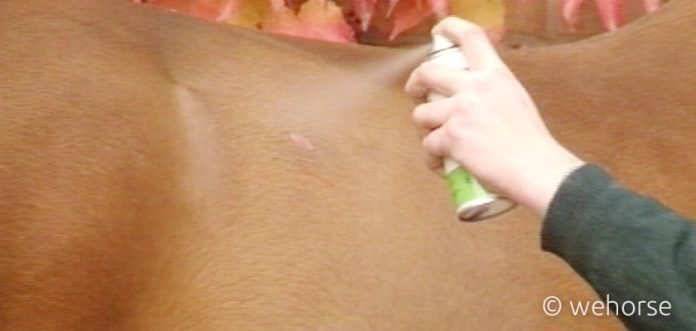Injuries and ailments can – literally – get under your horse’s skin. These are often associated with side effects that affect not only the horse’s appearance, which makes good horse wound care all the more important.
1. How to take care of your horse’s skin?
2. What you can do to keep the skin of your horse healthy?
3. How to treat a wound?
4. How to desinfect a wound properly?
5. What should you have in your first aid kit?
The skin is a genuine multi-talent, fulfilling a variety of tasks. It encases the body, and protects the inner organs from both outside influences and mechanical forces. Healthy skin prevents bacteria, viruses and parasites from entering. Subcutaneous fat serves both as a cushioning and as thermal insulation. A horse’s body temperature, which remains largely constant, is likewise regulated predominantly through the skin. The skin also acts as an excretory organ, discharging bodily waste products through various glands. And, of course, it’s an important sensory organ that transmits external stimulations.
How to take care of your horse’s skin?
The skin can only fulfill these important functions when it’s intact. As an anatomical barrier between the internal organism and the external environment, however, the outer shell is notably exposed – and therefore sensitive – to harmful influences. The consequences: skin irritations, superficial wounds, chafing, inflammations and weeping eczema.
Here are 5 things you should take care of:
- Shield the skin from the sun: allowing your horse to spend as much time as possible outdoors is great but keep in mind that just like you, your horse can get sunburned. Grey horses or horses with white markings are the more susceptible. Make sure there is shade in the turnout arena, not all horses will use it but might take advantage of the cooler temperature. Applying sunblock on the sensitive skin parts can also help, as well as protecting them with fly masks.
- Protect the horse against flies: not only insect bites are annoying for the horse but they can also trigger violent physical reactions. The use of fly spray as well as covering your horse with the appropriate fly sheets can save you a lot of problems.
- Limit the sharing of tack or grooming tools: brushes or saddle pads can easily carry skin diseases. Make sure to disinfect your grooming tools regularly and that only horses with healthy skin share tacks or brushes.
What can you do to keep the skin of your horse healthy?
“Some problems are even home-made”, veterinary surgeon Nicole Beusker points out. “Frequent washing with shampoo, for example, makes conditions favorable for skin ailments when the natural protective cover of the horse’s skin is destroyed.” Metabolic disorders, internal diseases and nutritional deficiencies can also cause changes to the horse’s skin and coat. Despite different causes, the signs are often similar: common symptoms are dry bald spots, inflamed areas and infections. Skin irritations are often accompanied by severe itching, from which horses seek relief by rubbing against objects. This creates wounds, and in turn entry points for germs and pathogens.
How to treat a wound?
You can treat superficial wounds yourself, so long as you stick to some basic rules:
- Cleanliness is the be-all and end-all of horse wound care. Beusker: “Ideally you should wear disposable gloves, or at least wash your hands before you treat the wound.” Iodine solutions and compresses, for example, are suitable for carefully swabbing wounds to the horse’s skin. Another tip: “It is recommended that the hairs along the edges of the wound be clipped or carefully shaved to prevent them from sticking.”
- Keep the wound dry but hydrated: if you have just desinfected the wound, dry it with a clean towel before applying a specific cream that will serve as a barriere agaiinst germs and bacteries.
- In some cases, applying a bandadge can help it stay clean and safe from infections, if you don’t know how to do it, don’t hesitate to call your vet.
How to disinfect a wound properly?
An antiseptic salve can be applied to the cleaned wound. This salve may contain iodine or skin nurturing, antiseptic ingredients.
Germs and pathogens are present everywhere around us. If wounds become infected, the healing process may be substantially impaired.
It is not surprising that silver has been rediscovered as a remedy, and that its antimicrobial, antibacterial and anti-inflammatory effects are being touted in the new horse wound care preparations coming onto the market. Diverse salves and creams specially intended for horse wound care and general skin care boast being made “with microsilver” or “with colloidal silver”. This is because silver kills off bacteria!
What you should have in your first aid kit?
Providing effective first aid to an injured horse can make a great difference fot its recovery, having a fully-stocked first aid kid is a great start.
Here is what you should have:
- Scissors
- Rectal thermomether
- Latex gloves
- Roll of ductape
- Hemostat and/or tweezer
- Clean towel
- Antiseptic scrub and wound cream
- Sterile gauzes
- Roll of elastikon
- Gauze roll for padding
Make sure to keep everything in a clean box with a secure lid and to check the expiration date of the perishable products regularly.







